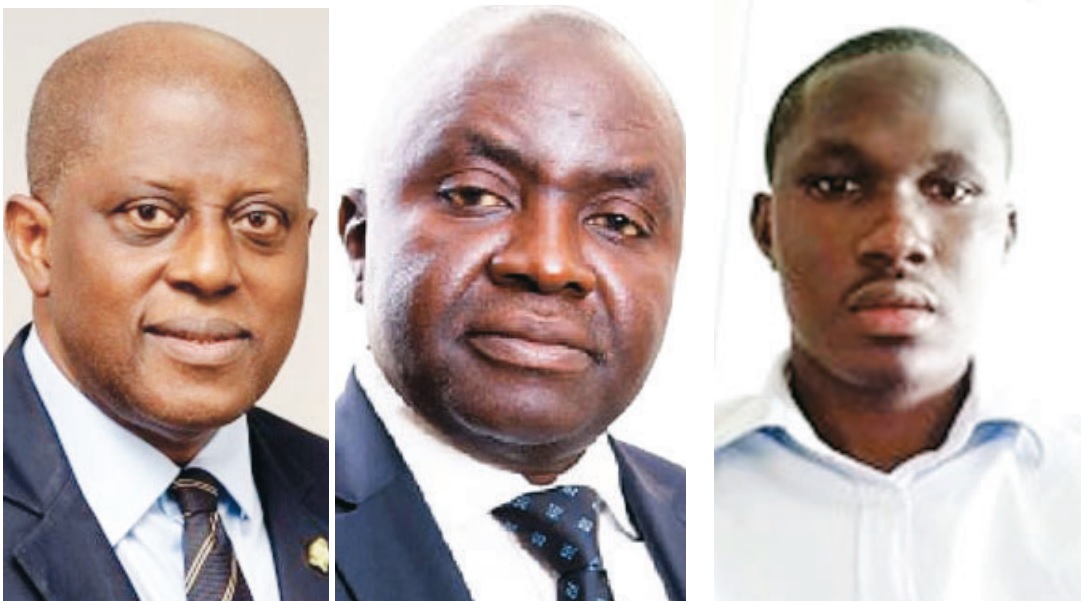By Nduka Chiejina,The Nation
Copyright thenationonlineng

The 302nd meeting of the Central Bank of Nigeria’s (CBN) Monetary Policy Committee (MPC), held on September 22 and 23, represents a pivotal moment in the country’s evolving monetary policy stance. Assistant Editor NDUKA CHIEJINA provides a comprehensive understanding of the MPC’s actions, their economic significance and the possible policy trajectory in the coming months.
With inflation showing a consistent downward trajectory for five consecutive months, oil production rebounding, foreign reserves strengthening and the Gross Domestic Products (GDP) growth accelerating, the Monetary Policy Committee (MPC) opted to slightly ease monetary policy. Specifically, the MPC reduced the Monetary Policy Rate (MPR) by 50 basis points to 27.00 percent, adjusted the Standing Facilities corridor to +250/-250 basis points, introduced a 75 percent Cash Reserve Requirement (CRR) on non-TSA public sector deposits and kept the Liquidity Ratio at 30 percent.
This decision is significant for several reasons. It signals cautious optimism by policymakers who, while satisfied with macro-economic improvements, remain wary of latent risks such as excess liquidity in the banking system and lingering fiscal pressures. Moreover, the move underscores the CBN’s balancing act: consolidating the disinflationary momentum while cautiously supporting economic recovery in an environment of fragile global and domestic uncertainties.
The policy rate cut: A symbolic yet cautious step
The decision to cut the MPR by 50 basis points—from 27.50 per cent to 27.00 per cent—is the first rate reduction since the tightening cycle began in 2022. It comes after an extended period of aggressive monetary tightening aimed at containing inflation that had peaked above 30 percent in late 2023. By mid-2025, inflation had not only slowed but also shown consistency in its downward path, providing policymakers with some room to manoeuvre.
The modest nature of the cut reflects prudence. Rather than a bold reduction that could reignite inflationary pressures, the MPC opted for a symbolic easing, signalling confidence in the disinflation process while maintaining a broadly restrictive stance. With the real policy rate turning slightly positive—given inflation at 20.12 percent in August 2025—the CBN is effectively sustaining its inflation-targeting credibility while cautiously encouraging lending and investment.
The reduction also conveys a shift in emphasis: while price stability remains paramount, the MPC is beginning to recognise the need to support output growth. The Nigerian economy, having expanded by 4.23 per cent in Q2 2025 compared to 3.13 per cent in Q1, appears to be regaining momentum. By nudging the policy rate lower, the CBN is sending a signal to businesses and consumers that monetary conditions may gradually become less restrictive, provided inflationary risks remain under control.
Inflation dynamics: Disinflation gains momentum
Headline inflation fell to 20.12 percent in August 2025 from 21.88 per cent in July, marking the steepest monthly decline in five months. Importantly, this was driven by both core and food components. Core inflation slowed to 20.33 per cent, aided by lower costs in services, housing, utilities and logistics. Food inflation, historically Nigeria’s Achilles heel, also eased to 21.87 per cent; reflecting lower prices of staple foods such as rice, maize, millet and guinea corn. Several factors underpin this disinflationary trend: they include: Exchange rate stability, anchored by stronger reserves and higher oil receipts, reduced imported inflation; monetary tightening over the past two years had cumulative dampening effects on demand; improved agricultural supply and expectations of a strong harvest season contributed to moderating food prices; and declining PMS prices further eased cost-push pressures.
Read Also: Strike: No disruption to petrol supply – PENGASSAN
This multi-faceted disinflation reinforces the MPC’s credibility. For years, inflation in Nigeria has been sticky due to structural bottlenecks—poor logistics, insecurity affecting agriculture, and heavy fiscal injections into the economy. The fact that inflation is not only decelerating but also broad-based across components is a sign that monetary policy transmission is strengthening. Still, at over 20 per cent, inflation remains far above the CBN’s implicit comfort zone (single digits). Hence, while the cut in the MPR is justified, the CBN cannot afford complacency. The risk of reversal is high, especially if fiscal spending spikes or insecurity disrupts food supply.
Output growth: Oil recovery as a game-changer
The MPC’s communiqué drew attention to Nigeria’s output resilience, particularly the turnaround in the oil sector. GDP growth accelerated to 4.23 per cent in Q2 2025, compared to 3.13 per cent in Q1. A critical driver was the oil sector, which expanded by an impressive 20.46 percent year-on-year, a sharp rebound from 1.87 percent in Q1. This surge reflects improved oil production following enhanced security measures in the Niger Delta and progress in curbing crude theft. It also comes at a time when global oil prices remain supportive, boosting foreign exchange inflows and fiscal revenues. Non-oil growth remains steady; supported by services, ICT and trade. However, challenges persist in agriculture and manufacturing, where structural bottlenecks—such as inadequate power supply, high transport costs, and insecurity—continue to constrain performance.
The policy implication is clear: sustained oil output growth provides a crucial buffer for Nigeria’s balance of payments and government finances, but non-oil diversification must remain a priority to avoid overdependence. The MPC rightly called on government to intensify security and agricultural reforms, recognising their centrality in consolidating both disinflation and growth.
External sector: Reserves strengthen and FX market stabilises
Foreign exchange stability has been one of the CBN’s notable achievements in recent months. Gross external reserves rose to US$43.05 billion as of September 11, 2025, from US$40.51 billion at end-July. This translates to an import cover of 8.28 months—well above international adequacy benchmarks. Additionally, the current account balance recorded a surplus of US$5.28 billion in Q2 2025, up from US$2.85 billion in Q1. Stronger oil exports and rising capital inflows, particularly portfolio investments attracted by high yields in the Nigerian debt market, played key roles.
The stability of the naira in the official and parallel markets has helped to anchor inflation expectations and restore investor confidence. The MPC explicitly recognised this, urging the CBN to sustain policies that deepen FX liquidity and attract inflows. For investors, Nigeria’s improved external buffers reduce sovereign risk and enhance debt sustainability. However, the reliance on oil revenues and portfolio inflows remains vulnerability. Any sharp reversal in global oil prices or capital flow volatility could test the durability of the naira’s stability.
Liquidity management: The 75% CRR innovation
One of the more innovative measures announced was the introduction of a 75 per cent cash reserve requirement (CRR) on non-TSA public sector deposits. This decision reflects the MPC’s concern over excess liquidity in the banking system, largely stemming from fiscal disbursements funded by improved revenues. By sterilising a large portion of public sector deposits outside the Treasury Single Account (TSA), the CBN aims at reducing the liquidity overhang and its potential inflationary impact. At the same time, the CRR for commercial banks was adjusted to 45 per cent, while merchant banks’ CRR remains at 16 per cent.
This targeted tightening shows the CBN’s willingness to deploy unconventional tools alongside interest rates to manage liquidity. For banks, however, the measure could constrain loanable funds, especially for institutions heavily reliant on public sector deposits. This may inadvertently raise intermediation costs unless balanced by improved efficiency in the interbank market—hence the simultaneous adjustment of the standing facilities corridor. The MPC commended the banking system’s resilience, noting that 14 banks have already met the new capital requirements under the ongoing recapitalisation programme. This progress is significant in strengthening financial stability, especially as Nigeria seeks to build a banking sector capable of financing long-term infrastructure and industrial growth.
Equally important was the termination of forbearance measures, particularly waivers on single obligor limits. This move enhances transparency, reinforces risk management discipline and reduces the risk of concentration in bank loan books. While the transition may cause short-term adjustments, the MPC reassured the public that the impact is temporary and does not threaten financial stability. The recapitalisation exercise could position Nigerian banks to compete more effectively with regional peers and support larger credit portfolios. However, challenges remain, particularly in ensuring that smaller banks can raise sufficient capital without triggering consolidation pressures that may disrupt the system.
Looking ahead, the MPC projects continued disinflation in the coming months, supported by the delayed effects of past tightening, stable exchange rates, lower PMS prices and the onset of the harvest season. The main challenge will be to maintain this momentum while avoiding premature easing. If inflation continues to decelerate towards the 15–18 percent range by early 2026, the CBN may gradually adopt further rate cuts to stimulate credit and investment. However, any fiscal slippage, external shock or resurgence of insecurity could derail progress. The MPC’s next meeting in November 2025 will thus be critical as it will provide an opportunity to assess whether the September cut was an inflection point towards easing or a one-off adjustment within an otherwise restrictive stance.
Cardoso reinforcing the MPC’s message
In his interaction with journalists after the September 2025 MPC meeting, the Central Bank Governor, Olayemi Cardoso, situated the Committee’s decisions within Nigeria’s broader economic reform journey. He reminded Nigerians of the state of the economy just two years ago, when foreign exchange shortages were acute, investors were exiting, and confidence in the naira was at its lowest.
Cardoso said: “We have basically come from two years ago, where, perhaps, things were in a very bad situation … foreign exchange was difficult, many of the investors were taking flight, and people had lost confidence in the currency. We have moved forward in stabilising the economy. The reforms we have undertaken have been open and transparent and have brought results.”
The CBN Governor pointed to the improved recognition Nigeria has received from the international community, noting that rating agencies such as Moody’s and Fitch have systematically upgraded the country’s outlook in response to reforms. He stressed that while challenges remain, the process of stabilization is not a sprint but a journey that has already created a platform for sustainable growth. On inflation, Cardoso maintained the CBN’s long-term target: “We are pleased that we are seeing consecutive disinflation. This is the fifth time, consecutive. But I want to say something for the avoidance of doubt: our goal is for single digits. That is where we are headed, and we will not stop until we get there.”
He stated that the MPC’s work is rooted in data, foresight and risk management, projecting both internal and external shocks before they materialise. This proactive, data-driven approach, he argued, explains the MPC’s steady actions over recent months. He also addressed the political context, particularly with the 2026 election campaign season on the horizon: “We are not oblivious to the fact that we are entering an election campaign year ahead of 2027. We are building resilience, building buffers, and will take the actions necessary to ensure that the well-earned stability continues.”
He noted that the central bank’s efforts cannot succeed in isolation. The collaboration with the Ministry of Finance and the Coordinating Minister for the Economy has been central to the progress made so far, especially in moderating inflation and stabilising the exchange rate. Going forward, this partnership will be deepened. Cardoso emphasised the importance of exchange rate stability and fiscal discipline in sustaining the disinflationary path, while warning about the risks of excess liquidity arising from government fiscal releases. The newly introduced tools, including the 75 per cent CRR on non-TSA deposits, are aimed at addressing such risks to preserve macroeconomic stability.
On foreign reserves, Cardoso was particularly optimistic. He explained that reserves had reached their highest level since 2019 due to sustained policy measures, transparency, and renewed investor confidence. Initiatives such as the non-resident NRBVN programme, which initially attracted $200 million per month and has since doubled, are now being scaled further. “Going into next year, we are saying we are going to attain $1 billion a month. And we will do it. New initiatives, creativity, having an open system, and giving confidence to potential investors will drive our reserves level on a very positive upward trajectory,” he said.
Through these responses, Cardoso reinforced the MPC’s communiqué that Nigeria is moving from crisis management to stability, from defensive measures to proactive reforms, and from weak credibility to restored international recognition. The journey, he stressed, is ongoing—but the progress to date provides a firm foundation for cautious optimism about the country’s economic trajectory.
Balancing optimism with structural realities
Commenting on the September 2025 MPC decision and Governor Cardoso’s remarks, the Managing Director and Chief Executive Officer of Ambosit Capital Managers, Dr Wahab Balogun, described the move as a measured step that reflects both confidence and caution. According to the analyst, the reduction of the Monetary Policy Rate (MPR) to 27 per cent sends a signal that the CBN is beginning to relax its extremely tight stance, but the modest size of the cut shows that the bank remains wary of potential inflationary pressures. “The CBN has done well to recognise the disinflationary trend and reward the economy with a small rate cut. But the message is clear: they are not letting their guard down. Inflation at 20 percent is still very high, so this is not the start of a loose policy cycle — it is a cautious test of the waters,” he said.
He commended the Governor’s reaffirmation of a single-digit inflation target, describing it as ambitious but necessary. However, Dr Balogun noted that interest rate policy alone cannot deliver single-digit inflation. “The Governor is right to say that single-digit inflation is the goal. But achieving it will require more than monetary tightening or easing. Structural reforms in agriculture, power supply and logistics are critical. Without tackling these supply-side constraints, inflation will remain sticky,” he said.
On external reserves and exchange rate stability, Dr. Balogun agreed with Cardoso’s optimism but urged caution. “Reserves at over $43 billion and the NRBVN inflows are very encouraging. But we must remember that Nigeria is still highly dependent on oil earnings and volatile portfolio inflows. One shock in global oil markets or global capital markets could reverse these gains. So, while the trajectory is positive, policymakers must continue to build resilience.” he said.
The introduction of the 75 per cent CRR on non-TSA deposits was described as an innovative but potentially double-edged measure. “It is a smart way to mop up excess liquidity from government spending without punishing private sector credit. However, the high CRR for commercial banks generally could still constrain lending to businesses, especially SMEs. The CBN will have to carefully monitor how this affects credit growth and economic activity,” he said.
On collaboration between the CBN and the Ministry of Finance, Balogun argued that it is one of the most significant takeaways from Cardoso’s remarks. “For too long, Nigeria has suffered from poor coordination between fiscal and monetary authorities. The fact that Cardoso openly acknowledges the importance of working closely with the Finance Ministry is a very positive shift. If fiscal discipline holds, and the Ministry avoids excessive spending during the election season, the CBN’s disinflation gains can be sustained,” he said.
Looking ahead to 2026—an election campaign year—he flagged the risk of political pressures. “Election cycles in Nigeria usually come with heavy fiscal spending, and that creates liquidity surges that fuel inflation and exchange rate instability. Cardoso says the CBN is ready to build buffers, but history shows how difficult this period can be. The true test of Nigeria’s new monetary framework will be in how it navigates the election season,” he said.
Finally, Dr. Balogun praised the CBN Governor for placing Nigeria’s progress in the context of international recognition. “When Moody’s and Fitch start to upgrade Nigeria, that is not just about ratings. It signals to global investors that the country is regaining credibility. This is perhaps the most valuable achievement of the reforms so far — rebuilding trust. Once trust is restored, capital will flow more easily, reserves will strengthen and growth can be sustained,” he said.
Contributing, the Chief Executive Officer of the Centre for the Promotion of Private Enterprise (CPPE), Dr Muda Yusuf said: “The CBN’s decision marks a significant policy shift toward supporting growth and investment, following an extended period of aggressive monetary tightening to rein in inflation.” Continuing, Dr. Yusuf said: “The MPC’s move toward supporting growth is ‘logical and timely,’ given that the bank has now restored a measure of macro-economic stability and slowed inflationary pressures.”
He observed that high interest rates have constrained private sector credit, increased the cost of funds, and negatively affected business expansion. He stated that by adjusting the key policy levers, the central bank is making a deliberate effort to improve economic conditions. “By lowering the MPR and CRR, the CBN is deliberately working to improve liquidity conditions, reduce borrowing costs, and unlock capital for productive sectors of the economy,” he said. He further detailed the expected outcome for businesses and the wider economy: “The combination of lower MPR and reduced CRR should expand banks’ capacity to create credit, lowering lending rates and making financing more accessible for businesses, especially small and medium enterprises (SMEs). Lower cost of funds will encourage new investments, support business expansion, and enhance capacity utilisation in the real sector. This will, ultimately, stimulate output growth and job creation.”
Dr. Yusuf also noted that the broader financial impact will be “more accommodative monetary environment that will enable banks to fulfil their core function of mobilising savings and channelling them into productive investments, reinforcing financial deepening and economic growth.” Expressing his view on the accompanying measures, Dr Yusuf described the decision to impose a 75 per cent CRR on non-TSA public sector deposits as a “prudent measure to prevent excessive fiscal-driven liquidity injections from destabilising the financial system.” Concluding, Dr. Yusuf stressed that while monetary easing is a welcome development, fiscal policy must play a complementary role to fully unlock the country’s growth potential.
The September 2025 MPC decision reflects a delicate balancing act by the CBN. By cutting the policy rate slightly while tightening liquidity conditions through CRR adjustments, the Committee is cautiously supporting growth without compromising disinflation gains. Nigeria’s macro-economic environment is improving: inflation is slowing, growth is accelerating, reserves are rising and the banking sector is strengthening. Yet, vulnerabilities persist in the form of fiscal liquidity injections, structural bottlenecks, and global uncertainties.
Ultimately, the MPC’s cautious optimism is well-founded. If current trends continue, Nigeria could enter 2026 with lower inflation, stronger growth and a more resilient financial system. However, the CBN must remain vigilant, as the path to macro-economic stability is neither straight nor predictable.



